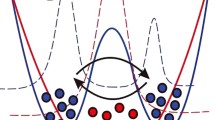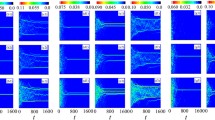Abstract
We have studied the dynamics of a two-site Bose–Einstein condensate subject to tunnelling coupling (which makes the system a bosonic Josephson junction), having on-site inter-particle interaction (making the system a small Bose–Hubbard model) and in contact with two separate heat baths, which makes the system lossy and potentially drives it into a non-equilibrium state with some heat current. The dynamical calculation of the system is done within the standard quantum generalized Langevin setting, and the heat baths are assumed to have non-zero memory time (Ornstein–Uhlenbeck process). We numerically calculated the time evolution of the population imbalance, coherence and entanglement of the system. We have shown inter-particle interaction, noise and dissipation induced by BEC atoms-reservoir interaction that are crucial in affecting the dynamics of the mentioned physical parameters. The study also indicates that quantumness (non-classicality) of the system is characterized by the interplay between dissipation and inter-particle interaction.





Similar content being viewed by others
References
A.P. Chikkatur, Y. Shin, A.E. Leanhardt, D. Kielpinski, E. Tsikata, T.L. Gustavson, D.E. Pritchard, W. Ketterle, Science 296, 2193 (2002)
Y. Shin, M. Saba, T.A. Pasquini, W. Ketterle, D.E. Pritchard, A.E. Leanhardt, Phys. Rev. Lett. 92, 050405 (2004)
J. Javanainen, Phys. Rev. Lett. 57, 3164 (1986)
G.J. Milburn, J. Corney, E.M. Wright, D.F. Walls, Phys. Rev. A 55, 4318 (1997)
T. Zapata, F. Sols and A.J. Leggett. Phys. Rev. A 57, 4318 (1998)
B.D. Josephson, Phys. Lett. 1, 251 (1962)
A. Smerzi, S. Fantoni, S. Giovanazzi, S.R. Shenoy, Phys. Rev. Lett. 79, 4950 (1997)
S. Raghavan, A. Smerzi, S. Fantoni, S.R. Shenoy, Phys. Rev. A 59, 620 (1999)
M. Albiez, R. Gati, J. Følling, S. Hunsmann, M. Christiani, M.K. Oberthaler, Phys. Rev. Lett. 95, 010402 (2005)
T. Zibold, E. Nicklas, C. Gross, M.K. Oberthaler, Phys. Rev. Lett. 105, 204101 (2010)
J. Ruostekoski, D.F. Walls, Phys. Rev. A 58, R50 (1998)
C. Lazarou, G.M. Nikolopoulos, P. Lambropoulous, J. Phys. B: At. Mol. Opt. Phys. 40, 2511 (2007)
G.M. Nikolopoulos, C. Lazarou, P. Lambropoulous, J. Phys. B: At. Mol. Opt. Phys. 41, 025301 (2008)
K.K. Rajagopal, S.V. Muniandy, Physica A 440, 118 (2015)
Y. Khodorkovsky, G. Kurizki, A. Vardi, Phys. Rev. Lett. 100, 220403 (2008)
E. Boukobza, M. Chuchem, D. Cohen, A. Vardi, Phys. Rev. Lett. 102, 180403 (2009)
D. Witthaut, F. Trimborn, S. Wimberger, Phys. Rev. Lett. 101, 200402 (2008)
F. Trimborn, D. Witthaut, S. Wimberger, J. Phys. B: At. Mol. Opt. Phys. 41, 171001 (2008)
F. Trimborn, D. Witthaut and H. J. Korsch. Phys. Rev. A 79, 013608 (2009)
F. Trimborn, D. Witthaut, H. Henning, G. Kordas, T. Geisel, S. Wimberger, Eur. Phys. J. D. 63, 63 (2011)
D. Witthaut, F. Trimborn, H. Henning, G. Kordas, T. Geisel, S. Wimberger, Phys. Rev. A 83, 06368 (2011)
G. Kordas, S. Wimberger, D. Witthaut, Phys. Rev. A 87, 043618 (2013)
W. Wang, L.B. Fu, X.X. Yi, Phys. Rev. A 75, 045601 (2007)
K.K. Rajagopal, Physica A 429, 231 (2015)
E. Ghasemian, M.K. Tavassoly, Laser Physics 27, 095202 (2017)
V. Guarrera, P. Würtz, A. Ewerbeck, A. Vogler, G. Barontini, H. Ott, Phys. Rev. Lett. 107, 160403 (2011)
G. Barontini, R. Labouvie, F. Stubenrauch, A. Vogler, V. Guarrera, H. Ott, Phys. Rev. Lett. 110, 035302 (2013)
R. Kosloff, Entropy 15, 2100 (2013)
P. Hofer et al., New J. Phys. 19, 123037 (2017)
C.W. Gardiner, P. Zoller, Quantum Noise: A Handbook of Markovian and Non-Markovian Quantum Stochastic Methods with Applications to Quantum Optics, 2nd edn. (Springer, Berlin, 2000).
A.J. Leggett, Review of Modern Physics 73, 307 (2001)
U. Weiss Quantum Dissipative Systems, 3d ed. World Scientific, Singapore. (2008)
K. Lindenberg and B.J. West. The non-Equilibrium Statistical Mechanics of Open and Closed System. VCH New York. (1990)
V.V. Sargsyan, G.G. Adamian, N.V. Antonenko, D. Lacroix, Phys. Rev. A 90, 022123 (2014)
G.E. Uhlenbeck, L.S. Ornstein, Phys. Rev. 36, 823 (1930)
R.L.S. Farias, R.O. Ramos, L.A. da Silva, Brazilian J. Physics 38, 499 (2008)
R.L.S. Farias, R.O. Ramos, L.A. da Silva, Comp. Phys. Comm. 180, 574 (2009)
M.O. Scully, M.S. Zubairy, Quantum Optics, 6th edn. (Cambridge University Press, U.K., 2009).
Y. Yamamoto and A. İmamoǵlu. Mesoscopic Quantum Optics John-Wiley and sons,Inc., New York (1999)
K.K. Rajagopal, G. Ibragimov, Brazilian J. Physics 50, 178 (2020)
M. Hillary, M.S. Zubairy, Phys. Rev. Lett 96, 050503 (2006)
M. Hillary, M.S. Zubairy, Phys. Rev. A 74, 032333 (2006)
Acknowledgements
We acknowledge the wise reviewers for their careful review and fruitful suggestions in improving this manuscript. The work is done with very limited resources.
Author information
Authors and Affiliations
Corresponding author
Additional information
Publisher’s Note
Springer Nature remains neutral with regard to jurisdictional claims in published maps and institutional affiliations.
Appendices
A Appendix
The Markovian (Mark) Model
We show the dynamics of the double-well BEC out-coupled to reservoirs model operating within the Markovian dissipation basis. Assumptions of the model is stated in Section 1. Substituting the memory-less dissipative kernels \(K_{\delta }(t)=Q_{1}\delta (t)\) and \(M_{\delta }(t)=Q_{2}\delta (t)\) in Eqs. (7) and (8), integrals of the dissipation terms drop out giving the following standard Markovian dissipative two-mode BEC dynamical equations in a straight forward way:
where the noise term in the above equation is denoted by (\(\tilde{F}_{a}\), \(\tilde{F}_{a}\)) to distinguish with the non-Markovian noise terms (\(\hat{F}_{a}\),\(\hat{F}_{a})\). The two-point noise–noise correlations for the Markovian system [38, 39] are:
which can also be easily shown by utilizing Ohmic spectral function and definition of random noise term (see line below Eqs. 7 and 8). It needs to be mentioned that, Eqs. (30) and (31) indicate fluctuation–dissipation theorem (FDT) which implies that fluctuation due reservoir gives rise to the damping in the system. The calculation for the non-Mark FDT is more involved where one needs to compute them using Lorentzian spectral function.
Other physical parameters such as population of traps (\(n_{A}(t)=\langle \hat{a}^{\dagger }\hat{a}\rangle\), \(n_{B}(t)=\langle \hat{b}^{\dagger }\hat{b}\rangle\)), coherence term (\(n_{AB}(t)=\langle \hat{a}^{\dagger }\hat{b}\rangle\)) and other noise correlated terms can be obtained by computing their second-order moments using the above equation and applying the product rule 17. Doing some algebra, we obtain the following set of evolution equations:
In the above set of equations, terms \(\langle \tilde{F}^{\dagger }_{a}\hat{a}\rangle = \langle a^{\dagger }\tilde{F}_{a}\rangle = [Q_{1}/2]N_{1}(\omega )\) and \(\langle \tilde{F}^{\dagger }_{b}\hat{b}\rangle = \langle b^{\dagger }\tilde{F}_{b}\rangle = [Q_{2}/2]N_{2}(\omega )\) were obtained using technique shown in [39]. The fourth-order moments generated in deriving Eq. (32)-(34) have been decorrelated by a basic relations \(<\hat{A}\hat{B}\hat{C}\hat{D}> \approx<\hat{A}\hat{B}> <\hat{C}\hat{D}>\), similar to Eqs. (18)-(24) of the non-Mark model. The set of dynamical equations above are governed by the trap frequency \(\omega\), tunnelling coupling constant \(\Omega\), inter-particle interaction strength U, dissipation strengths (\(Q_{1}\), \(Q_{2}\)) and the reservoir temperatures \((T_{1},T_{2})\). The comparison between noise non-Mark and the Mark is illustrated in the figures reported.
B The Mean-field (MF) Model
Redefining the macroscopic dynamics of the BECs within a Mean-Field approximation (MFA) by \(\alpha =\langle \,\hat{a}\,\rangle\), \(\alpha ^{*}=\langle \,\hat{a}^{\dagger }\,\rangle\), \(\beta =\langle \,\hat{b}\,\rangle\) and \(\beta ^{*}=\langle \,\hat{b}^{\dagger }\,\rangle\) with \(n(t)=|\alpha |^2+|\beta |^2=n_{A}(t)+n_{B}(t)\) denoting the total particle number at certain time t in the double-well. Following the condition on reservoir described in section (1), the noise of reservoir averages out to \(\langle \,\hat{F}_{a}\,\rangle\) and \(\langle \,\hat{F}_{b}\,\rangle\) zero for large system. Next we decorrelate the third-order correlation functions appearing on the right-hand side of Equations (7) and (8) by the relations \(\langle \hat{a}^{\dagger }\hat{a}\hat{a}\rangle\) \(\approx\) \(\langle \hat{a}^{\dagger }\rangle\) \(\langle \hat{a}\rangle\) \(\langle \hat{a}\rangle\) and \(\langle \hat{b}^{\dagger }\hat{b}\hat{b}\rangle\) \(\approx\) \(\langle \hat{b}^{\dagger }\rangle\) \(\langle \hat{b}\rangle\) \(\langle \hat{b}\rangle\). This approximation is equivalent to the Mean-Field approximation where the higher-order correlations are decorrelated into the form \(\langle \hat{a}^{\dagger }\hat{a}\hat{a}\rangle\) \(\approx\) \(\langle \hat{a}^{\dagger }\hat{a}\rangle\) \(\langle \hat{a}\rangle =|\alpha |^2\alpha\) and \(\langle \hat{b}^{\dagger }\hat{b}\hat{b}\rangle\) \(\approx\) \(\langle \hat{b}^{\dagger }\hat{b}\rangle\) \(\langle \hat{b}\rangle =|\beta |^2\beta\).
With these approximations, we obtain a closed set of coupled nonlinear differential equations describing our system of interest:
where the last terms Eq. (35) and Eq. (36) are :
Eqs.(35)- (40) are the essential equations for the non-Markovian Mean-Field model. Comparison between the noise correlated models shown in the reported figures.
Rights and permissions
About this article
Cite this article
Rajagopal, K.K., Ibragimov, G. Non-equilibrium Dynamics of a Double-well Bose–Einstein Condensate-dual Reservoir System. Braz J Phys 51, 944–953 (2021). https://doi.org/10.1007/s13538-021-00904-9
Received:
Accepted:
Published:
Issue Date:
DOI: https://doi.org/10.1007/s13538-021-00904-9




